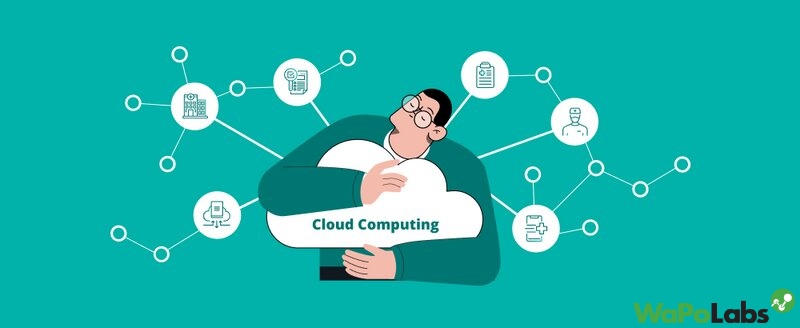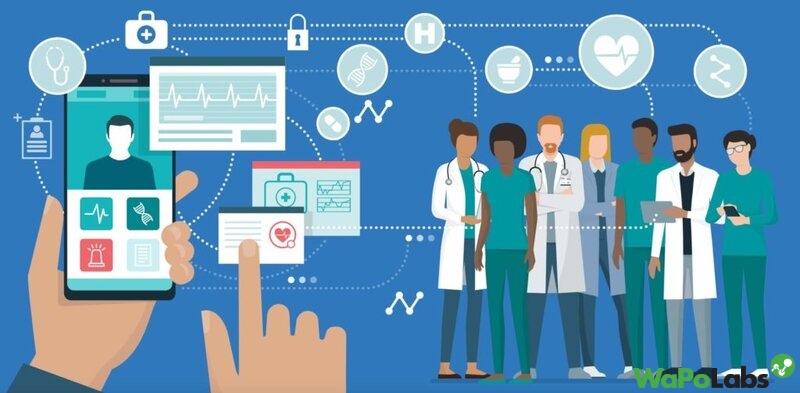The healthcare industry is on an innovation spree. Security, predictability, accessibility, and affordability are all areas where technology is making a contribution to the industry.
When we talk about technology solutions that are developing the healthcare domain for the better, we frequently talk about blockchain, AI, IoT, and sometimes even software-based medical devices called SaMD, but the one that really serves as a backbone for any of these next-gen technological advances is cloud computing – one of the healthcare domain’s all-time technological trends.
Cloud computing in health care has resulted in a significant shift in the generation, usage, storage, and transfer of medical data. When it comes to optimizing data management strategies, the industry has advanced a long way since the days of traditional storage to now, thanks to the complete digitalization of healthcare information.
In this article, we will look at the various aspects of cloud computing in health care and see how it is revolutionizing the field.
What Is a Cloud-Based Healthcare Application?
In the healthcare market, cloud computing refers to the technique of implementing remote servers accessible via the Internet to store, operate, and process healthcare-related data. In contrast, constructing an on-site data center with servers or hosting the statistics on a personal computer are both options.
Cloud storage is a versatile solution that enables healthcare professionals and hospitals to use a network of remotely accessible servers to store massive amounts of information in a secure environment managed by IT professionals.
Since the implementation of the Electronic Medical Records (EMR) Mandate, healthcare organizations throughout the United States have embraced cloud-based healthcare solutions as a method of keeping and protecting patient records.
The global cloud computing for healthcare market is predicted to reach $35 billion by 2022, with an annualized rate of growth of 11.6%, according to BCC research.
Despite this, 69% of survey participants in a 2018 survey said their hospital did not have a plan in place to migrate existing data centers to the cloud.
So, what are the advantages of cloud computing in healthcare, and how does the cloud be used in healthcare services?

What Are the Benefits of Cloud Computing in Health Care?
Here are some advantages of using cloud computing in health care:
Lowered healthcare cost
The main premise of healthcare cloud computing is the accessibility of computer resources like data storage and computing power in live time. Healthcare providers and hospitals are both relieved of the need to purchase data storage hardware and software. Furthermore, there are no upfront costs associated with the cloud for healthcare; they will only be charged for the resources that they use.
Cloud computing applications in healthcare can provide an ideal environment for scaling without breaking the bank. With patient data coming in not only from EMRs but also via healthcare apps and wearable devices, a cloud environment allows for storage to be scaled while keeping costs down.

Make it simpler to work with data
Healthcare organizations work with data such as patients’ contact and private details, medical and appointment history, insurance company data, and payment records. It is difficult to manually organize and process it. In turn, mistakes in a specific area are costly both literally and metaphorically. Analytics tools in the cloud make this task more approachable, effective, and insightful.
Machine learning and artificial intelligence capabilities play a significant role in patient treatment and also in operational effectiveness. Cloud computing in the healthcare sector may assist users to manage massive amounts of data because more cloud platforms incorporate AI and ML into their services.

Collaborative Patient Care Has Been Simplified
The use of cloud storage for electronic health records has streamlined the procedure of collaborative patient care in the United States. Cloud storage makes it simpler for doctors to visualize or share a patient’s health records in a collaborative manner.
Traditionally, a patient’s health records were likely kept in separate files at each doctor, expert, or hospital they visited.
This made it challenging for doctors to work together on the patient’s care.
The widespread use of cloud storage in hospital services, particularly in relation to electronic medical records, makes it simpler for doctors to exchange information with one another, see the outcomes of interactions between all the other physicians and the client, and provide treatment that takes into account what the patient has previously experienced with other doctors.

Drives Medical Research
Similar to the way that clouds computing will allow healthcare providers to utilize big data and analytics in facility administration, future research scientists will benefit greatly from the digitization of health data via cloud-based data storage.
Aside from the accumulation of large amounts of data, the cloud enables clinical researchers to utilize previously unavailable amounts of computing power.
Even as recently as 2005, a medical researcher who wished to analyze a large data set would be required to request time at one of the nation’s supercomputing centers, where they would have to wait several weeks on a waiting list. Researchers can use the cloud to access supercomputer-like analytical capability within their own time and at a cost that is significantly less.

Growth of Telemedicine
The application of cloud computing in health care has accelerated the increase of telemedicine. Cloud-based software and telehealth systems aid in the sharing of healthcare data, the provision of patient medical insurance during treatment, prevention, and recovery, and the improvement of availability.
Moreover, many apps include more advanced features such as virtual medicine consumption analysis or doctor’s appointments via video conferencing. In a nutshell, cloud computing is the key to improved medical care through telemedicine.

Offer Flexibility and Scale Easily
Beyond the immediate cost savings associated with using cloud storage over on-premises data storage, organizations have a long-term advantage from simpler upgrades and lower scaling costs. Cloud storage solution providers for health care use economies of size to reduce data management costs for their clients, which are hospitals and treatment centers.
Cloud computing in healthcare also provides extra flexibility due to the typical pay-as-you-go data storage business model. When healthcare facilities construct their own digital storage solutions, they should evaluate how much ability they require and spend their own money to boost that capacity as storage space becomes limited. With cloud-based solutions, all it takes is a phone call to your service supplier to increase your capacity for storing data to the levels you require.
Cloud-based healthcare solutions are highly scalable and can grow in tandem with your business.

Enhanced patient experience
Doctors can improve patient engagement by providing real-time access to health information, test results, and even doctors’ notations with the assistance of the cloud for healthcare. As patients are becoming more educated about their well-being, they gain control over their health.
Furthermore, cloud computing in health care prevents patients from being overprescribed or dragged into unneeded testing, the specifics of which may be found in health records.

Improve access to health care services
Telemedicine is indeed a modern health tech trend that allows patients to receive medical care from a distance. During the Covid pandemic, it has become an indispensable tool. And without it, distant consultations allow people with disabilities and those living in remote areas to avoid having to travel to traditional clinics.
One of the most significant advantages of cloud computing in health care is the capability to deal with regular communication with a health care professional, particularly after surgery or an operation. The same could be said regarding a timely reminder to take medication, among other things. Physicians could even continually monitor vitals from home using cloud-connected wearable technology. This feature allows doctors to quickly make decisions, which saves clients’ lives.

Superior Data Security
Previously, physicians who stored reams of health records in filing systems faced a serious threat of data being lost or damaged. Paper records are easily misplaced or stolen, and they can be totally destroyed in the event of a flood, fire, or other natural catastrophes. The documents’ lack of security posed a significant risk to patient safety.
Once the EMR mandate was in place, health care providers could set up their own on-site digital storage infrastructure; however, this would necessitate the retention of IT staff knowledgeable in information security to make sure that patient data was secure.
As a replacement, health care providers can use HIPAA-compliant cloud storage services to outsource digital data and safety. These services focus on providing patient EMR data storage that fully complies with legally mandated data security and privacy demands. “The cloud” has aided in ensuring that every health care provider has the ability to access a storage system that adequately protects sensitive patient data.

Final Words about Cloud Computing in Health Care
Transforming to the cloud entails more than just implementing a Cloud Management Platform (CMP). The important thing is to introduce Automation and Orchestration. Its rapidity enables quick Time-To-Market and adaptability to market changes. Its intelligence elevates process efficiency to new heights. Its service-driven abilities open up limitless opportunities for innovation. The Cloud XaaS Service-driven model is an easy-to-understand layman concept that simply connects cloud transformation to the business plan, gaining a competitive advantage, designing new income streams, and becoming more flexible in the face of disruptive changes in the market.

Through strategic alignment, IT is transformed from a help desk to a profit center. The key is to simplify. It serves no purpose if the Cloud is too complicated to begin with, too expensive to justify, and too large to protect. Now is the ideal time to justify and accelerate Cloud Transformation and the journey toward Smart Healthcare realization.
Hope that the above article helps you grasp a basic understanding of the important roles of cloud computing in health care.
Wapolabs USA
- Address: 1301 K Street NW Washington, D.C., U.S. 20071
- Phone: 0190-8286
- Email: [email protected]
- Website: https://www.wapolabs.com
- Instagram: https://www.instagram.com/wapolabs/
